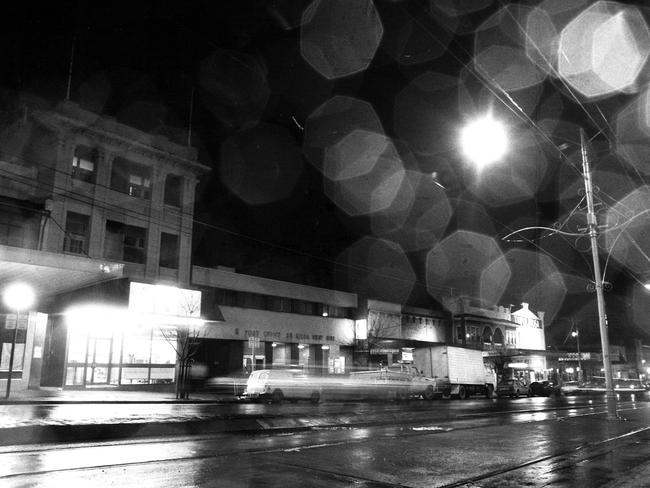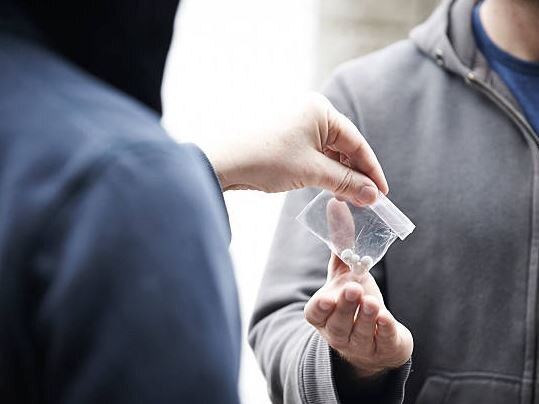Undercover Cop podcast: The art of pulling off the imperfect drug raid
An undercover cop pushing a pram. A .38 pistol hidden beneath a baby doll. A dealer waiting for a heroin delivery to his St Kilda flat. What could possibly go wrong? Listen to the podcast.
Police & Courts
Don't miss out on the headlines from Police & Courts. Followed categories will be added to My News.
When Lachlan McCulloch’s creation “Dean Collie” wandered onto the streets to join St Kilda’s sordid parade of losers, boozers and users, no one took any notice. Which was exactly his cunning plan.
“Dean” used to tell anyone who bothered to ask that he was down from Shepparton and had just started shooting up “gear”.
McCulloch’s girlfriend was a nurse and he got a needle from her and jabbed it repeatedly into one spot in his arm so he could show dealers his “tracks” to prove his bona fides as a user.
He was a method actor, playing live on Fitzroy St.
“To get the effect of drugs I would scratch my fake track marks and rub my eyes to make them red. I would even sniff water to try to give me a runny nose.”
The devil was in the details. If a suspicious dealer pulled up Dean’s sleeves to make sure he was a junkie, there were the track marks to go with the red eyes and running nose. It worked.
Whenever the shambling, muttering figure weaved along Fitzroy St, ignored by almost everyone but McCulloch’s back-up police, things happened.
If the derelict-looking junkie scored a small amount of “smack” then the dealer would usually be arrested minutes later.
If dealers drove a luxury car, wore designer clothes or flashy jewellery, so much the better. They soon regretted the vulgar displays of affluence that appeal to people who push heroin.
“If they were waving a flag up and down the street that said ‘I can beat the coppers,’ they never lasted long,” McCulloch would recall.
“I’d turn myself into Dean Collie once or twice a week. One night, one of Dean’s heroin trafficker victims who had got bail spotted me (as Dean) and got curious about certain things. In fact, he decided to interview me as to why he happened to get arrested seconds after selling me heroin.
“The trouble was, he treated it like a real interview by a real old-style detective. He started to attack me. At first it was verbally, then physical. He took to punching me in the head and kicking me.
“I had a gun under my jacket and a big police radio tucked down the back of my pants and a tape recorder as well.”
But “Dean” didn’t want to blow his cover by fighting back too well, and especially by revealing obvious police gear. He tried to avoid getting hurt too badly until his back-up crew “happened” to spot the altercation and intervene.
“The dealer was then interviewed until he couldn’t stand up,” he recalls.
Dean Collie had to retire for a while, to let a new crop of dealers replace the ones who’d gone to jail or been persuaded never to show their heads in St Kilda. But the disguise was good for an occasional comeback. Dressed as Dean Collie the derelict, McCulloch became the invisible man.
Later, he graduated from posing as a heroin user to a heroin dealer because no one trusted a junkie, especially dealers. To catch big fish, he had to swim with sharks.

It was obvious that McCulloch was one of a group of young police who did their best work out of uniform. The system drafted him into a group of like-minded officers from the “big four” inner suburban stations on the south side of the Yarra: St Kilda, Prahran, South Melbourne and Port Melbourne.
These were called District Support Groups and McCulloch was in the Prahran division, one of two St Kilda representatives in the group.
Looking back on it later, he realised it was the most satisfying job he’d ever do: doing plainclothes work in the best training ground in the land. For a while, protecting the community was what he recalls as “a hell of a lot of fun.”
After a few months of growing their hair and wearing jeans, T-shirts and runners, the “troops” looked like a motley bunch of misfits and layabouts. In between jobs they would sit around like teenagers, with feet on seats, smoking, tossing balls around the room.
One had the disconcerting habit of shooting a small crossbow (seized from a crook) into a dart board on the wall. Sometimes he hit it.
Another had a dozen padlocks on a cord and would practise picking them with a pick lock set. They called him “Harry”, as in Houdini.
Harry’s lock picks were an alternative to the “10-pound key”, as in sledgehammer, when discretion was needed.
They did a lot of raids but one stuck in McCulloch’s memory. He had been fishing on the streets and landed information, as he put it to the crew, “that an unknown male driving an unknown vehicle is going to deliver an unknown quantity of heroin to an unknown male living in an unknown flat situated at 147 Steven St, St Kilda.”
Jokes aside, what he knew was that the previous day he’d used binoculars to watch the block of flats in Steven St and saw a man come out and use a public telephone nearby then go back inside. Within minutes a late model Ford sedan turned up. The driver, wearing a black leather jacket and sunglasses, went into the flats for three minutes.
“My information is that he does this daily,” he told the crew.
He had their attention — a “cunning plan”. They would pose as council workers, complete with two council trucks, ride-on mowers, whipper snippers, branch cutters and rakes, and start work in the park opposite the flats. This would allow them to see the drug courier arrive but not necessarily which flat the dealer lived in.

The plan was to pretend to work until the drug courier arrived, arrest him then produce a search warrant for the buyer’s flat. By McCulloch’s calculations, the buyer was taking an ounce of pure heroin (at a cost of $12,000) every morning and cutting it with glucose powder to “street heroin” which would be sold at $90 per half a gram for a total of about $80,000. Every day.
The hole in the plan was to identify the buyer’s flat. Without the precise address it would be impossible to get a search warrant. McCulloch’s idea to cover this was for Sandy, the only female in the group, to wheel a pram (complete with life-size baby doll) around the flats as if looking for a friend’s address just as the buyer emerged or returned. Once she had done this, he predicted optimistically, he could insert the flat number in front of the street address on the warrant.
“I left a little space for that on the warrant.”
What could go wrong?
For a start, Sandy had trouble fending off nosy mothers wanting to look at her fake baby as she wheeled the pram around the park well before the usual 10am drop-off time.
The buyer emerged and looked suspiciously at the “council workers” then went to the phone box. Sandy and her pram happened to intercept him on his way back to the flat.
She asked him which flat an old friend of hers might live in. He was most helpful. While Sandy was knocking on another door she saw him enter flat seven, which sorted out the warrant for later. But they still had to intercept the wholesale dealer.
The work crew had cut all the park grass repeatedly and had run out of work. They pulled out a football and started to kick around it, as if on a break. This display enraged a local busybody who demanded to know who was in charge. When directed to “the boss”, McCulloch, she abused him for wasting ratepayers’ money and demanded to know his name.
“I am Senior Council Worker Bartholomew Aardvark,” he told her solemnly. He then lost interest in the conversation because a big silver Ford was coming down the street.
As it stopped, one of the crew grabbed a sledgehammer and the others produced guns. The busybody stopped complaining and backed away.
Sandy casually reached into the pram and pulled a .38 pistol from under the doll. She and McCulloch and Darren O’Loughlin walked up behind the man, who was on the ground and handcuffed in a few seconds.

They heard the splintering crash of the sledgehammer on the door of flat seven. Then McCulloch looked up and saw a strange thing … an oddly familiar silver Ford turning into the street. Which meant they had arrested the wrong man — but here came the right one, providing he wasn’t spooked.
McCulloch hid his pistol and limped onto the road, yelling “Help, help! There’s been an accident.”
As he reached the Ford’s door he saw that the driver was wearing a black leather jacket, unlike the innocent man they’d cuffed. He pulled out his pistol and pointed it at the real dealer’s head.
O’Loughlin emphasised the need for the man to stay still by sitting on the bonnet and pointing a shotgun at him.
The dealer froze. McCulloch dragged him out and searched him. It wasn’t looking good until he pulled off the man’s huge cowboy boots and a lump of rock heroin fell out.
Meanwhile, the innocent man was complaining. McCulloch uncuffed him, helped him to his feet, brushing him down like a valet and thanked him warmly for assisting the Victoria Police to arrest a major heroin dealer.
The man hurried away, tripping over in his haste, and hid until it was all over.
As for flat seven, inside it was a very unhappy heroin buyer with $50,000 cash, scales, a grinder and glucose powder: the complete drug-cutting kit, complete with traces of heroin. Perfect evidence.
Then they searched the wholesale dealer’s Ford. It had $15,000 cash hidden in the console.
After it was all over, the crew went to the pub to celebrate nailing another dealer who’d taken a sudden fall from being well-dressed, arrogant, confident, smooth and “cashed up” with obscene amounts of money.
McCulloch mused about it later.
“Money is power and dealers are loaded. They don’t have to go to work every day or struggle with the mortgage. They want something, they buy it.”
In other words, they present to the world as highly successful. But as soon as the handcuffs go on, McCulloch says, “They turn into slimy, insignificant weeds that can’t even look in the mirror. They drop their shoulders and lower their heads. The truth is they are bottom dwellers.”





